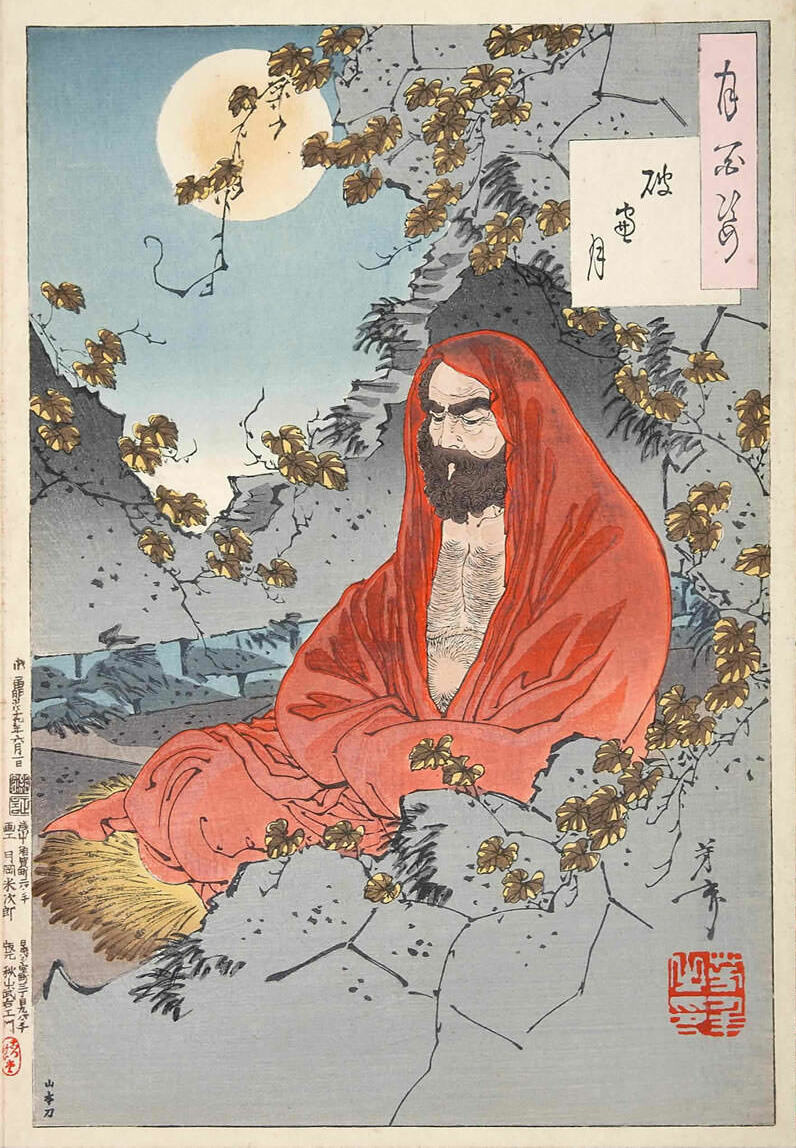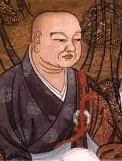|
Prajnatara
Prajñātārā, also known as Keyura, Prajnadhara, or Hannyatara, was the twenty-seventh patriarch of Indian Buddhism according to Chan Buddhism, and the teacher of Bodhidharma. Life According to The Transmission of the Lamp Little independent information about the life of Prajñātārā exists outside of The Jingde Record of the Transmission of the Lamp, a hagiographic account of the lives of early Indian and Chinese masters in the Chan tradition. Prajñātārā was from a Brahmin family in eastern India and was orphaned at a young age. Without a family name, Prajñātārā was called 'Precious Necklace' or 'Keyura' before ordination. When the 26th Patriarch, Punyamitra, came to visit the king of Prajñātārā's region, Punyamitra stopped the king's carriage on seeing Prajñātārā bowing. Prajñātārā was identified as having been Punyamitra's student in a previous incarnation, and Punyamitra identified Prajñātārā as an incarnation of the Bodhisattva Mahasthamaprapta. P ... [...More Info...] [...Related Items...] OR: [Wikipedia] [Google] [Baidu] |
Punyamitra
Punyamitra was the 26th Indian Patriarch of Chan Buddhism. A legendary figure, little information about him exists outside of Buddhist hagiographic texts. He is estimated to have died late in the 4th Century CE. Biography According to the Transmission of the Lamp According to The Jingde Record of the Transmission of the Lamp ''The Jingde Record of the Transmission of the Lamp'' (), often referred to as ''The Transmission of the Lamp'', is a 30 volume work consisting of putative biographies of the Chan Buddhist and Zen Buddhist patriarchs and other prominent Buddhist ..., Punyamitra was the eldest son of a king of southern India known as Virtuous Conqueror. Punyamitra's father favored the teaching of certain heretical Brahmin sects, and had Punyamitra imprisoned for reproaching the king for favoring these Brahmins. After the robe of Bahsyashita, the 25th Patriarch, was miraculously unburned despite being thrown into a fire, the king relented and ordered Punyamitra's release. Up ... [...More Info...] [...Related Items...] OR: [Wikipedia] [Google] [Baidu] |
Bodhidharma
Bodhidharma was a semi-legendary Bhikkhu, Buddhist monk who lived during the 5th or 6th century CE. He is traditionally credited as the transmitter of Chan Buddhism to China, and is regarded as its first Chinese Lineage (Buddhism), patriarch. He is also popularly regarded as the founder of Shaolin kung fu, an idea popularized in the 20th century, but based on the 17th century Yijin Jing and the Daoist association of ''daoyin'' gymnastics with Bodhidharma. Little contemporary biographical information on Bodhidharma is extant, and subsequent accounts became layered with legend and unreliable details. According to the principal Chinese sources, Bodhidharma came from the Western Regions, which typically refers to Central Asia but can also include the Indian subcontinent, and is described as either a "Persians, Persian Central Asian" or a "South Indian [...] the third son of a great Indian king." Aside from the Chinese accounts, several popular traditions also exist regarding Bodhi ... [...More Info...] [...Related Items...] OR: [Wikipedia] [Google] [Baidu] |
The Jingde Record Of The Transmission Of The Lamp
''The Jingde Record of the Transmission of the Lamp'' (), often referred to as ''The Transmission of the Lamp'', is a 30 volume work consisting of putative biographies of the Chan Buddhist and Zen Buddhist patriarchs and other prominent Buddhist monks. It was produced in the Song dynasty by Shi Daoyuan (). Other than the '' Anthology of the Patriarchal Hall'', it represents the first appearance of "encounter dialogues" in the Chan tradition, which in turn are the antecedents of the famous kōan stories. The word ''Jingde'' (), the first two characters of the title, refers to the reign name of Emperor Zhenzong of Song, which dates the work to between 1004 and 1007 CE. It is a primary source of information for the history of Chan Buddhism in China, although most scholars interpret the biographies as largely hagiography. The lives of the Zen masters and disciples are systematically listed, beginning with the first seven buddhas (Gautama Buddha is seventh in this list). The "Lamp ... [...More Info...] [...Related Items...] OR: [Wikipedia] [Google] [Baidu] |
Denkoroku
is a kōan collection written in 1300 by Keizan Jokin Zenji, the Great Patriarch of Sōtō Zen Buddhism, based on approximately a year of his Dharma talks. The book includes 53 enlightenment stories covering 1600 or more years based on the traditional legendary accounts of Dharma transmission in the Sōtō lineage. Successive masters and disciples in the book are Shakyamuni Buddha circa 360 to 440 BCE in India, to Zen master Ejō in about 1230 or 1240 in Japan. While other translations are available as of 2012, this article was developed for the most part from the introduction and translator's note by Francis Dojun Cook. Synopsis Contents Dharma transmissions covered 28 ancestors from India and 23 from China, followed by Dōgen and Ejō in Japan. Out of modesty and his sense of propriety, Keizan, the 54th ancestor, omitted himself and Tettsu Gikai, one of his teachers who was a student of Ejō and was still alive in 1300. Each chapter is a few pages, except in a couple ca ... [...More Info...] [...Related Items...] OR: [Wikipedia] [Google] [Baidu] |
Buddhism
Buddhism, also known as Buddhadharma and Dharmavinaya, is an Indian religion and List of philosophies, philosophical tradition based on Pre-sectarian Buddhism, teachings attributed to the Buddha, a wandering teacher who lived in the 6th or 5th century Before the Common Era, BCE. It is the Major religious groups, world's fourth-largest religion, with about 500 million followers, known as Buddhists, who comprise four percent of the global population. It arose in the eastern Gangetic plain as a movement in the 5th century BCE, and gradually spread throughout much of Asia. Buddhism has subsequently played a major role in Asian culture and spirituality, eventually spreading to Western world, the West in the 20th century. According to tradition, the Buddha instructed his followers in a path of bhavana, development which leads to Enlightenment in Buddhism, awakening and moksha, full liberation from ''Duḥkha, dukkha'' (). He regarded this path as a Middle Way between extremes su ... [...More Info...] [...Related Items...] OR: [Wikipedia] [Google] [Baidu] |
Tara (Buddhism)
Tara (, ; , ), Ārya Tārā (Noble Tara), also known as Jetsün Dölma (Tibetan: ''rje btsun sgrol ma,'' meaning: "Venerable Mother of Liberation"), is an important female Buddha in Buddhism, especially revered in Vajrayana Buddhism and Mahayana Buddhism. She may appear as a female bodhisattva in Mahayana Buddhism. In Vajrayana Buddhism, Green Tara is a female Buddha who is a consort of Amoghasiddhi, Amoghasiddhi Buddha. Tārā is also known as a salvation, saviouress who hears the cries of beings in saṃsāra and saves them from worldly and spiritual danger. In Vajrayana, she is considered to be a The Buddha, Buddha, and the ''Tārā Tantra'' describes her as "a mother who gives birth to the buddhas of the three times" who is also "beyond Saṃsāra (Buddhism), saṃsāra and Nirvana (Buddhism), nirvāṇa."James B. Apple, "Atiśa’s System of Twenty-One Tārās", Revue d’Etudes Tibétaines, no. 66, Avril 2023, pp. 424-463. She is one of the most important female deities in ... [...More Info...] [...Related Items...] OR: [Wikipedia] [Google] [Baidu] |
Zen Patriarchs
Zen (; from Chinese: ''Chán''; in Korean: ''Sŏn'', and Vietnamese: ''Thiền'') is a Mahayana Buddhist tradition that developed in China during the Tang dynasty by blending Indian Mahayana Buddhism, particularly Yogacara and Madhyamaka philosophies, with Chinese Taoist thought, especially Xuanxue, Neo-Daoist. Zen originated as the Chan Buddhism, Chan School (禪宗, ''chánzōng'', 'meditation school') or the Buddha-nature, Buddha-mind school (佛心宗'', fóxīnzōng''), and later developed into various sub-schools and branches. Chan is traditionally believed to have been brought to China by the semi-legendary figure Bodhidharma, an Indian (or Central Asian) monk who is said to have introduced dhyana teachings to China. From China, Chán spread south to Vietnam and became Thiền, Vietnamese Thiền, northeast to Korea to become Korean Seon, Seon Buddhism, and east to Japan, becoming Japanese Zen. Zen emphasizes Buddhist meditation, meditation practice, direct insight int ... [...More Info...] [...Related Items...] OR: [Wikipedia] [Google] [Baidu] |
Indian Buddhist Monks
Indian or Indians may refer to: Associated with India * of or related to India ** Indian people ** Indian diaspora ** Languages of India ** Indian English, a dialect of the English language ** Indian cuisine Associated with indigenous peoples of the Americas * Indigenous peoples of the Americas ** First Nations in Canada ** Native Americans in the United States ** Indigenous peoples of the Caribbean ** Indigenous languages of the Americas Places * Indian, West Virginia, U.S. * The Indians, an archipelago of islets in the British Virgin Islands Arts and entertainment Film * ''Indian'' (film series), a Tamil-language film series ** ''Indian'' (1996 film) * ''Indian'' (2001 film), a Hindi-language film Music * Indians (musician), Danish singer Søren Løkke Juul * "The Indian", an unreleased song by Basshunter * "Indian" (song), by Sturm und Drang, 2007 * "Indians" (song), by Anthrax, 1987 * Indians, a song by Gojira from the 2003 album '' The Link'' Other uses ... [...More Info...] [...Related Items...] OR: [Wikipedia] [Google] [Baidu] |
457 Deaths
__NOTOC__ Year 457 ( CDLVII) was a common year starting on Tuesday of the Julian calendar. At the time, it was known as the Year of the Consulship of Constantinus and Rufus (or, less frequently, year 1210 ''Ab urbe condita''). The denomination 457 for this year has been used since the early medieval period, when the Anno Domini calendar era became the prevalent method in Europe for naming years. Events By place Roman Empire * January 27 – Emperor Marcian dies at Constantinople, possibly of foot gangrene, an infection contracted during a long religious journey. He is buried in the Church of the Holy Apostles, together with his late wife Pulcheria. * February 7 – Leo I, a Thraco-Roman (or Dacian) high-ranking officer, becomes the new emperor of the Eastern Roman Empire, reigning for nearly 20 years. He is first to accept the Byzantine crown from the hands of the patriarch of Constantinople. * April 1 – Majorian is acclaimed emperor by the Roman army, ... [...More Info...] [...Related Items...] OR: [Wikipedia] [Google] [Baidu] |
Korean Seon
Seon or Sŏn Buddhism (; ) is the Korean name for Chan Buddhism, a branch of Mahāyāna Buddhism commonly known in English as Zen Buddhism. Seon is the Sino-Korean pronunciation of Chan, () an abbreviation of 禪那 (''chánnà''), which is a Chinese transliteration of the Sanskrit word of ''dhyāna'' ("meditation"). Seon Buddhism, represented chiefly by the Jogye and Taego orders, is the most common type of Buddhism found in Korea. A main characteristic of Seon Buddhism is the use of the method of meditation, Ganhwa Seon. A Korean monk, Jinul accepted partially a meditative method of Chan Buddhism in 1205. In Chan Buddhism, ''hwadu'' () is a delivery of realising a natural state of the Awakening. Jinul addressed a doctrine of Sagyo Yiepseon () that monks should live an inborn life after learning and forgetting all creeds and theories. Within the doctrine of Jinul, ''hwadu'' is the witnessing of truthful meaning in everyday life. History During the Goryeo dynasty Jinu ... [...More Info...] [...Related Items...] OR: [Wikipedia] [Google] [Baidu] |






